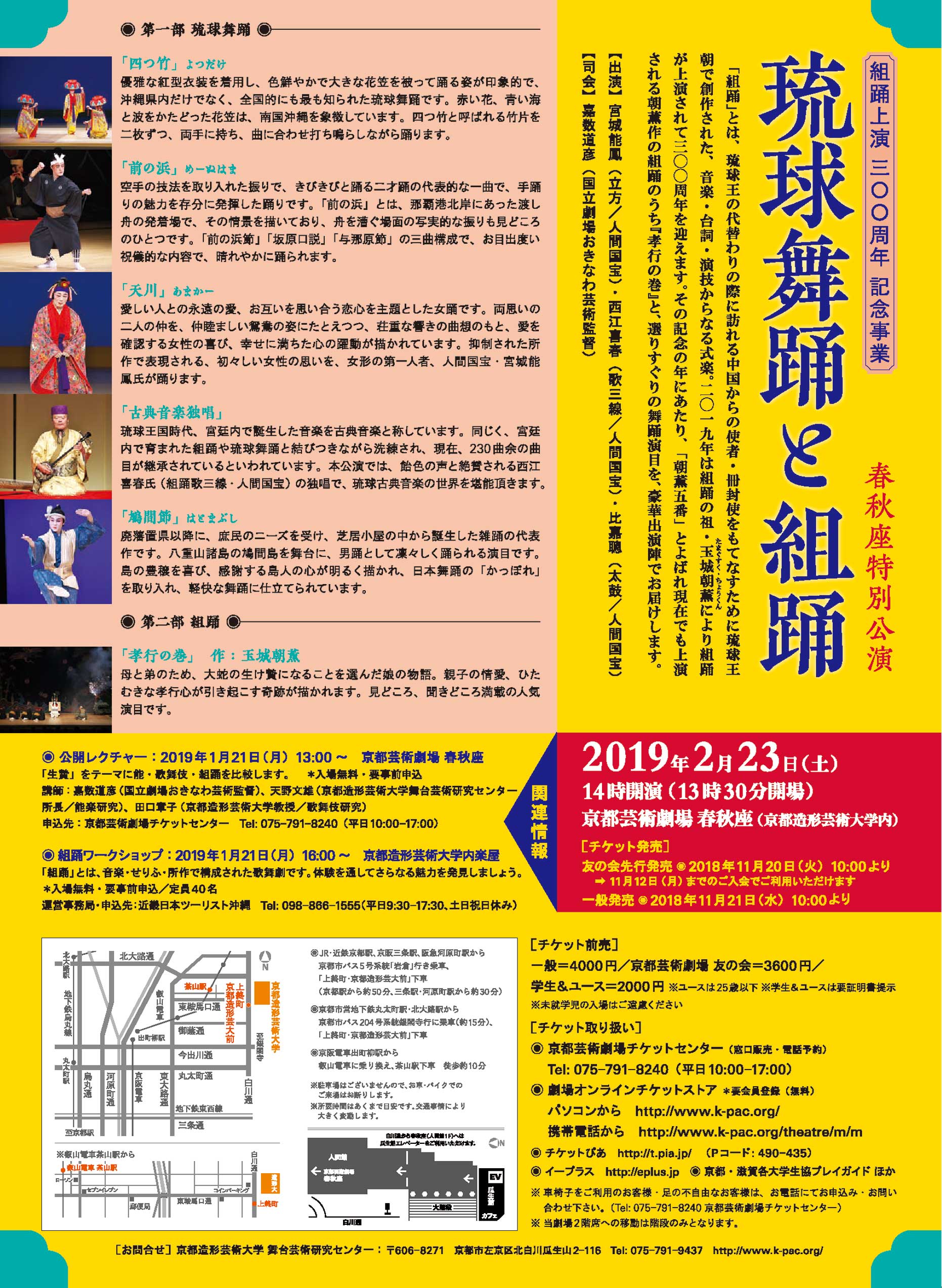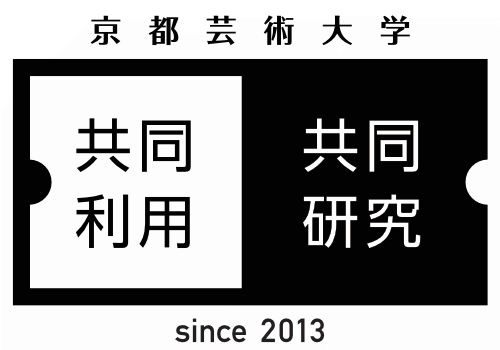公演詳細
主催公演
主催:京都造形芸術大学舞台芸術研究センター
公益財団法人国立劇場おきなわ運営財団
組踊上演300周年記念事業
琉球舞踊と組踊 春秋座特別公演
組踊『孝行の巻』
琉球舞踊と組踊の二部構成で、琉球王朝時代の古典芸能をお楽しみいただきます。
「組踊」とは、琉球王の代替わりの際に訪れる中国からの使者・冊封使をもてなすために琉球王朝で創作された、音楽・台詞・演技からなる式楽です。2019年は組踊の祖・玉城朝薫(たまぐすく・ちょうくん)により組踊が上演されて300周年を迎えます。その記念の年にあたり、”朝薫五番”とよばれ現在でも上演される朝薫作の組踊のうち『孝行の巻』を豪華出演陣でお届けします。
 劇場ニュースレターに組踊の特集を掲載しております。
劇場ニュースレターに組踊の特集を掲載しております。
併せてご覧ください。
【関連展示のお知らせ】
2/23(土)「琉球舞踊と組踊 春秋座特別公演」では、公演当日、春秋座ロビーにて、
紅型(びんがた)衣装や、「組踊」の紹介パネルを展示いたします。
紅型は沖縄が誇る伝統工芸で、独自の染色技法で染め上げられたもの。
琉球舞踊・組踊では、衣装として着用されていますが、大変貴重な文化財でもあります。
2019年に上演300周年をむかえる、琉球王朝がはぐくんだ芸能「組踊」について
よりよく知っていただき、色鮮やかな紅型を間近でご覧いただける機会です。
ぜひ展示もお楽しみに。

(2016年度「琉球舞踊と組踊」春秋座公演での展示の様子)
「組踊」とは、琉球王の代替わりの際に訪れる中国からの使者・冊封使をもてなすために琉球王朝で創作された、音楽・台詞・演技からなる式楽です。2019年は組踊の祖・玉城朝薫(たまぐすく・ちょうくん)により組踊が上演されて300周年を迎えます。その記念の年にあたり、”朝薫五番”とよばれ現在でも上演される朝薫作の組踊のうち『孝行の巻』を豪華出演陣でお届けします。
 劇場ニュースレターに組踊の特集を掲載しております。
劇場ニュースレターに組踊の特集を掲載しております。併せてご覧ください。
【関連展示のお知らせ】
2/23(土)「琉球舞踊と組踊 春秋座特別公演」では、公演当日、春秋座ロビーにて、
紅型(びんがた)衣装や、「組踊」の紹介パネルを展示いたします。
紅型は沖縄が誇る伝統工芸で、独自の染色技法で染め上げられたもの。
琉球舞踊・組踊では、衣装として着用されていますが、大変貴重な文化財でもあります。
2019年に上演300周年をむかえる、琉球王朝がはぐくんだ芸能「組踊」について
よりよく知っていただき、色鮮やかな紅型を間近でご覧いただける機会です。
ぜひ展示もお楽しみに。

(2016年度「琉球舞踊と組踊」春秋座公演での展示の様子)
公演情報
2019年2月23日(土)14:00
ロビーにて関連展示あり
ロビーにて関連展示あり
会場:春秋座
【出演】
宮城能鳳(立方/人間国宝)
西江喜春(歌・三線/人間国宝)
比嘉聰(太鼓/人間国宝)
他
【司会・解説】嘉数道彦(国立劇場おきなわ芸術監督)
第一部 琉球舞踊
◆女踊「四つ竹」(よつだけ)
◆◆◆踊り手:佐辺 良和 金城 真次 玉城 匠
◆二才踊「前の浜」(めーぬはま)
◆◆◆踊り手:川満 香多 天願 雄一
◆女踊「天川」(あまかー)
◆◆◆踊り手:宮城 能鳳
◆古典音楽独唱
◆◆◆歌三線 西江 喜春
◆雑踊「鳩間節」(はとまぶし)
◆◆◆踊り手 新垣 悟 田口 博章 佐喜眞 一輝
第二部 組踊「孝行の巻」
◆立方指導 : 宮城 能鳳 地謡指導 : 西江 喜春
【配役】
◆◆◆頭取 : 眞境名 正憲
◆◆◆おめなり : 佐辺 良和
◆◆◆おめけり : 金城 真次
◆◆◆母 : 宮城 能鳳
◆◆◆時の大屋子 : 金城 清一
◆◆◆供 : 新垣 悟 田口 博章 玉城 匠 佐喜眞 一輝
◆◆◆大蛇操作 : 川満 香多 天願 雄一
【地謡】
◆◆◆◆◆◆歌三線:西江 喜春 花城 英樹
◆◆◆◆◆◆◆◆◆◆玉城 和樹 神谷 大輔
◆◆◆◆◆◆◆◆箏:宮里 秀明 笛:横目 大哉
◆◆◆◆◆◆◆胡弓:平良 大 太鼓:比嘉 聰
公開レクチャー
2019年1月21日(月)13:00~ 京都芸術劇場 春秋座
「生贄」をテーマに能・歌舞伎・組踊を比較します。
※入場無料・要事前申込
講師:嘉数道彦(国立劇場おきなわ芸術監督)
◆◆◆天野文雄(京都造形芸術大学舞台芸術研究センター所長/能楽研究)
◆◆◆田口章子(京都造形芸術大学教授/歌舞伎研究)
申し込み先:京都芸術劇場チケットセンターTEL:075-791-8240(平日10時~17:00)
組踊ワークショップ
2019年1月21日(月)16:00~ 京都造形芸術大学内楽屋
「組踊」とは、音楽・せりふ・所作で構成された歌舞劇です。体験を通してさらなる魅力を発見しましょう。
※入場無料・要事前申込/定員40名
運営事務局・申込先:近畿日本ツーリスト沖縄 TEL:098-866-1555(平日9:30~17:30、土日祝日休み)
チケット情報
全席指定
《当日券情報》
当日券のご用意ございます。
当日13時より、チケットセンター窓口にて販売いたします。
一般発売 11月21日(水)10時
友の会先行発売 11月20日(火)10時
※友の会先行発売は11月12日(月)までのご入会でご利用いただけます。 ご入会方法はこちら
一般4000円 友の会3600円
学生&ユース 2000円

その他のプレイガイド



当日券のご用意ございます。
当日13時より、チケットセンター窓口にて販売いたします。
一般発売 11月21日(水)10時
友の会先行発売 11月20日(火)10時
※友の会先行発売は11月12日(月)までのご入会でご利用いただけます。 ご入会方法はこちら
一般4000円 友の会3600円
学生&ユース 2000円

その他のプレイガイド
English
Kumiodori 300th Anniversary
Ryukyuan Dance and Kumiodori at Shunjuza
23 February 2019, Saturday
Kyoto Art Theater Shunjuza
From 2 PM
Theater opens 1:30PM
With [Buyo] Miyagi Noho, [Uta/Sanshin] Nishie Kishun , [Taiko] Higa Satoshi and others
Ticket Now on sale
Reserved seat
General 4,000 yen
U-25 and Students 2000 yen
・U-25 and Students have a valid ID required for purchase and to enter.
Presented by Kyoto Performing Arts Center at Kyoto University of Art and Design, and
National Theater Okinawa
Supported by the Agency for Cultural Affairs,Government of Japan,and Prefecture of Okinawa
Program
Part 1: Ryukuan Dance
Ryukyuan dance can be basically categorized into “Traditional Dance”, “Zo Dance” and “Creative Dance”. Traditional Dance is developed as being performed on the stage for entertaining Imperial envoys (Sapposhi) from China during the Ryukyu Kingdom era and came to attain greatness in the 18th century. Traditional Dance is classified into four kinds; the old married couple’s Rojinodori, young boys’ Wakashuodori, young men’s gallantry expressed in Nisaiodori, and the Onnaodori female dance performed with fascinating Bingata-dyed colorful costumes. The Zo Dance appeared after Haihan-Chiken, the abolition of clans and the establishment of the prefectural system (after 1879). Adopting music and culture of commoners, it became popular. “Creative Dance” is created by dancers of modern times, and superior works are still being created one after another. In 2009, Ryukyuan Dance was designated as a National Important Intangible Cultural Property.
“Yochidaki/ Yotsudake”, women’s dance
“Me nu Hama”, Young men’s dance
“Amaka”, women’s dance, performed by Noho Miyagi, living national treasure
“Traditional Music Performance” by Kishun Nishie, living national treasure
“Hatuma Bushi”, zo dance
Part 2: Kumiodori
★The Kumiodori is a musical theater composed of words, music and dance. The Kumiodori was created by Tamagusuku Chokun who was appointed Odoribugyo, a dance magistrate, in the early 18th century in order to entertain Chinese envoys called Sapposhi sent by the Chinese Emperor to crown the new king of the Ryukyu Kingdom. NidoTekiuchi and ShushinKaneiri were first played at the King Sho Kei’s enthronement ceremony in 1719.
Chokun created the Kumiodori based on Okinawa’s indigenous performing arts and fables with inspiration from performing arts in mainland Japan (Noh and Kabuki) and Chinese theater. Mekarushi, Onnamonogurui and Kokonomaki together with the above mentioned two works are called “Chokun’s five masterpieces” and they are works with a high degree of perfection still popular to this day.
In 1972, the Kumiodori was designated a National Important Intangible Cultural Property as one of Japan’s superior performing arts. And in 2010 it was inscribed on the UNESCO Representative List of the Intangible Cultural Heritage of Humanity, and valued highly worldwide
Chokun created the Kumiodori based on Okinawa’s indigenous performing arts and fables with inspiration from performing arts in mainland Japan (Noh and Kabuki) and Chinese theater. Mekarushi, Onnamonogurui and Kokonomaki together with the above mentioned two works are called “Chokun’s five masterpieces” and they are works with a high degree of perfection still popular to this day.
In 1972, the Kumiodori was designated a National Important Intangible Cultural Property as one of Japan’s superior performing arts. And in 2010 it was inscribed on the UNESCO Representative List of the Intangible Cultural Heritage of Humanity, and valued highly worldwide
“Ko ko nu machi/ Kokonomaki”
A serpent living in a swamp called Muruchi was causing problems for local farmers by manipulating the weather. After a divination that a human sacrifice is needed in order to appease the serpent, the court brings a search for someone to sacrifice. Signs are posted that anyone willing to be sacrificed will have their family cared for once they are gone.
With this, a poor brother and sister, they find one of the signs. The sister convinces her brother that she should be the sacrifice in order to help the family. She makes him promise to keep this a secret from their mother and they return home to see her. When the girl meets their mother she lies to her and tells her that she is going to get water from the lake. Even though her mother feels a touch of uncertainly about what she has been told, she tells her daughter to be careful, and sends her on her way. The girl leaves their mother in the care of her brother and the two siblings make a tearful parting.
Just as the girl is about to be eaten by the serpent as a sacrifice, a god descends to earth and saves the girl by killing the serpent. Her mother, upon hearing of what she is doing, runs with her son to her daughter’s side. They are both happy that the girl is unhurt. The court, impressed with the girl’s devotion to her family, make her a princess and promises her brother a princess’ s hand in marriage. Their mother returns home happy.
Ticket
Box Office / Phone
Kyoto Art Theater Shunjuza
TEL 075-791-8240 (Mon-Fri 10:00-17:00)
Online * Pre-registration required
◆◆◆◆※credit card only (visa, mastercard)
◆◆◆◆◆Pick up tickets at local 7-Eleven convenience stores in Japan
Access
Kyoto Art Theater Shunjuza
Kyoto University of Arts and Design
2-116 Uryuyama, Kitashirakawa, Sakyo-ku, Kyoto 606-8271 Japan
From JR Kyoto station, Keihan Sanjo station, Hankyu Kawaramachi station
→Take bus #5 for Iwakura, get off at Kamihatecho Kyoto Zokei Geijyutsu Daigaku Mae (about 50 minutes from JR Kyoto)
From subway Marutamachi or Kitaoji station
→Take bus #204,get off at Kamihatecho Kyoto Zokei Geijyutsu Daigaku Mae (about 15 minutes from each station)
From Keihan Demachi Yanagi station
→Transfer to Eizan Densha line, get off at Chayama station. About 15 minutes-walk from Chayama.
→It takes 10 minutes by taxi to the University.
There is NO parking space for cars and motorcycles at the University.





